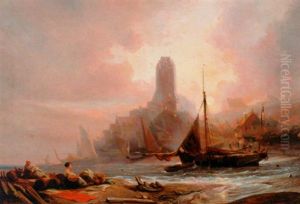Pierre Alexandre Poitevin Paintings
Pierre Alexandre Poitevin was a French sculptor born in 1819, whose work is less widely known today but was significant in the context of 19th-century French art. He was part of a generation of sculptors who contributed to the rich tapestry of French sculpture, a field that was experiencing a renaissance of sorts during his lifetime. Poitevin's career spanned a period of great change in the art world, including the rise of Romanticism, the impact of the 1848 Revolutions across Europe, and the emergence of Realism.
Poitevin was trained in the traditional academic style, which was prevalent at the École des Beaux-Arts in Paris. This institution was central to art education in France and Europe, nurturing talents who would go on to define the era's artistic direction. His work, however, straddled the academic traditions he learned and the new impulses of realism that were starting to influence the art scene. This blend of styles allowed him to create works that were both classical in their craftsmanship and modern in their subject matter and approach.
Throughout his career, Poitevin received various commissions, which included public monuments, religious sculptures, and decorative works. These commissions were a testament to his skill and the respect he had earned in artistic circles. Like many of his contemporaries, he sought to convey deeper meanings through his art, often exploring themes of human emotion, beauty, and the natural world. Despite the popularity he enjoyed during his lifetime, Pierre Alexandre Poitevin's name has not endured as prominently as some of his peers, such as Auguste Rodin or Jean-Baptiste Carpeaux.
Pierre Alexandre Poitevin passed away in 1905, leaving behind a legacy that, while perhaps not as celebrated today, contributed significantly to the development of sculpture in the 19th century. His works, though less frequently encountered, continue to be studied by art historians and appreciated by connoisseurs of 19th-century French art for their technical proficiency and emotional depth.


